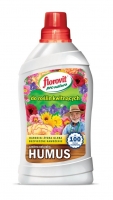Florovit pro natura organic-mineral fertiliser for flowering plants
Due to natural humic substances included in this fertiliser, as well as due to the influence it poses on soil and plants, Florovit pro natura for flowering plants resembles a compost or a manure. Humic substances stimulate a better growth and development of roots, as well as effective uptake of water and nutrients from the ground.
Regular application of the fertiliser ensures:
- intense growth and colours of leaves and flowers
- long and abundant flowering
Florovit pro natura for flowering plants:
- increases the fertility of the soil,
- ensures proper growth and abundant flowering,
- contains natural organic substances improving the quality of the soil,
- provides mineral substances crucial for proper growth and development of plants,
- restores proper soil structure for plants.
Method of application:
Home and balcony-terrace plants. Young plants or poorly growing plants, as well as salt-sensitive plants (e.g. hanging basket begonia, calathea, sanvitalia, fuchsia, primrose, cyclamen, celosia, guzmania, impatiens, verbena, diascia, gerbera) should be fertilised with 1% solution. Water the plants with the prepared solution every 7-10 days from April to October. Older plants or plants characterised by a more intense growth or less sensitive to salinity (such as geraniums, petunias, surfinias, poinsettia, bougainvillea, peace lilly, cantedeskias) should be fertilised with 2% solution of the fertiliser. Water the plants with the prepared solution every 7-10 days from April to October. During the winter period home plants should be fertilised once a month with 1% solution of the fertiliser.
Bedding display plants in the ground. During the initial period of growing the plant, fertilise the plant with 2% solution of the fertiliser. Water the plants with the prepared solution every 7-10 days. Older plants should be fertilised with 4% solution of the fertiliser about 3-4 weeks after planting them. Water the plants with the prepared solution every 7-10 days from the beginning of May till the end of August, applying about 200 ml of the working solution per plant.
Sposób stosowania:
Rośliny domowe i balkonowo-tarasowe. Rośliny młode lub o słabym wzroście oraz wrażliwe na zasolenie (np. begonia zwisająca, kalatea, sanwitalia, fuksja, pierwiosnek, cyklamen, celozja, guzmania, niecierpek, werbena, diastia, gerbera) należy nawozić 1% roztworem nawozu. Przygotowanym roztworem podlewać rośliny co 7-10 dni od kwietnia do października. Rośliny starsze lub o intensywnym wzroście oraz mniej wrażliwe na zasolenie (np. pelargonie, petunie, surfinie, poinsecja, bugenwilla, skrzydłokwiat, cantedeskia) należy nawozić 2% roztworem nawozu. Przygotowanym roztworem podlewać rośliny co 7-10 dni od kwietnia do października. W okresie zimowym rośliny domowe należy nawozić 1% roztworem nawozu 1 raz w miesiącu.
Rośliny rabatowe w gruncie. W początkowym okresie uprawy rośliny należy nawozić 2% roztworem nawozu. Przygotowanym roztworem podlewać rośliny co 7-10 dni. Rośliny starsze, po 3-4 tygodniach od posadzenia należy nawozić 4% roztworem nawozu Przygotowanym roztworem podlewać rośliny co 7-10 dni od początku maja do końca sierpnia stosując ok. 200 ml cieczy użytkowej na roślinę.
Date of application:
| I | II | III | IV | V | VI | VII | VIII | IX | X | XI | XII |
Composition of the fertiliser:
2.0% (N) total nitrogen; 2.3% (P2O5) water-soluble phosphorus pentoxide; 3.0% (K2O) water-soluble potassium oxide; 0.008% (B) total boron; 0.004% (Cu) total copper; 0.018% (Fe) total iron; 0.006% (Mn) total manganese; 0.006% (Zn) total zinc.
See the informative video:
Eco design Do It Yourself – pallet flower containers


























